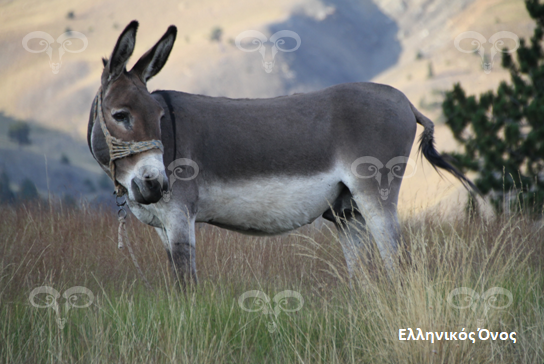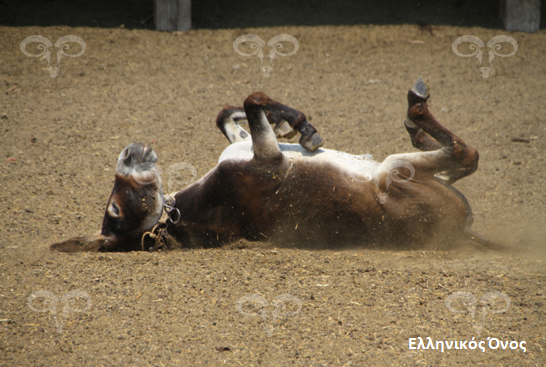History
The second member of the equine family that has lived in Greece for thousands of years is the ass or donkey (Equus africanus asinus). It is a member of the subspecies Asinus, which together with the other members of the genus Equus and the subgenus Hippotigris (zebras) make up the family of the Equidae.The donkey has lived in Greece at least since the 3rd millennium BC. Bones of domesticated donkeys have been found in Peloponnese, which date from 2750-2000 BC. The donkey, because of its exceptional characteristics, was an integral part of life and the daily routine of the Greeks. There are references to donkeys in Homer’s Iliad and as well as in works by Herodotos, Xenophon, Plutarch, Aristophanes, Plato and many others.
During the Roman period, donkey breeding farms were established, in various parts of Greece, to meet the needs of the Roman army and for the public. The best known studs were those of Arcadia, Attica and Magnesia. After the Roman and Byzantine periods there is no reference to organized donkey breeding.
Until a few decades ago donkeys were not separated into breeds, but rather into categories according to size. Internationally, there were six categories (according to some there were four), where the first category was made up of the smallest in size and the sixth the largest. In the last few decades there has been a tendency, especially in the western world, to develop new populations that did not previously exist. Thus, today man has bred donkeys, of all shapes and sizes.
Traditionally in the Greek domain there are two kinds of donkey: the Greek donkey, which belongs to the first size division, and the Cyprus donkey, which belongs to the fourth.
The absence of a breeders association, crossbreeding between the two main kinds and the free importation of foreign donkeys over the decades have given rise to the huge diversity observed in our country’s donkey population today. In the last decades, due to the ease of transportation, well-known donkey populations in isolated and inaccessible areas such as the Greek islands have lost their ‘purity’
Morphological Traits
The Greek donkey belongs to first size division which is usually called the “Mediterranean ass” because animals of similar size are also found in Italy, France, Spain and Portugal. It is one meter high at the withers and weighs about 120 kg.
Crossbred animals between the Greek donkey and other types of donkeys that exist in Greece are also considered native Greek donkeys. These donkeys usually belong to categories two and three. However, the great variability in the phenotype of these populations does not permit placing them in discrete groups. These donkeys weigh about 200 kg and their height rarely exceeds 125 cm at the withers.
The coat of the Greek donkey is short in the summer and longer in the winter. It is believed that all Greek donkeys possess the ‘dun’ gene. Greek donkeys have a dorsal stripe, shoulder stripe and dark rings on the legs, like those of the zebra.
The primary coat colours are grey-dun and bay-dun. However, the occasional black, brown or cream animal can be observed. The colour is uniform on the head and body, without white markings. The skin is always dark. Many animals have an intense discoloration on the muzzle, around the eyes and on the belly. The body is relatively narrow, with moderate muscular development.
Use
The donkey is by nature a calm, sociable and well-mannered animal. It is clever, learning quickly, has a good memory and realizes what is to its benefit. Contrary to the horse, it is a calm animal and does not panic easily; it does not react fitfully, quite the contrary, it will try to evaluate every possible danger. It is a careful and observant animal that thinks logically and will not hesitate to refuse to do something it considers dangerous. This is the reason why the donkey is considered stubborn’. The donkey loves its owner and, if treated well, it becomes obedient and patient, seeking human contact. Moreover, the donkey is well known for its devotion, its frugality and humility.
As opposed to horses, which evolved in cold to glacial regions, donkeys evolved in the deserts of northern Africa and the Arabian Peninsula; they are well adapted to life in the desert. They are abstemious and can be fed with almost all kinds of plants, even with thistles and wild artichokes. Therefore, the warm and dry conditions in Greece suit them perfectly.
The donkey has a life span of over thirty years provided it has not been mistreated during its lifetime. It has a slow growth rate but a long productive life and a high reproductive performance. Compared to the horse, the donkey is a very tough animal, able to carry heavy loads compared to its size. Donkeys are surefooted making them reliable and safer on rough ground and mountain trails.
Man took advantage of the donkey’s qualities, using it for all kinds of tasks. Its basic work was transportation, either harnessed to a cart or as a beast of burden. Even today it is irreplaceable in transport, especially on many islands where the villages are built on different levels and the houses can only be reached through narrow streets or cobblestone paths, in many mountain villages or islands such as Hydra.
Population
The donkey is undoubtedly the most durable and useful animal of the Greek countryside. It can be found in every part of the Greek domain. Nevertheless, its population has been on a constant decline in the last decades. According to data of the Hellenic Statistical Agency (2016), 3.653 donkeys were recorded throughout the country.
The total number of the Greek Donkey is unknown but it is estimated to be less than 300 animals, across the entire country. The population of the breed is classified as. ‘Critical’.




